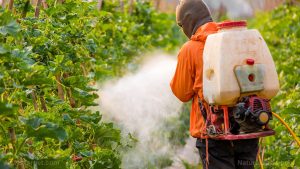
Procymidone – toxicity, side effects, diseases and environmental impacts
Thursday, November 23, 2017 by Zoey Sky
http://www.naturalpedia.com/procymidone-toxicity-side-effects-diseases-and-environmental-impacts.html

Procymidone is a dicarboximide fungicide with moderate systemic activity. While most uses of the fungicide involve foliar application, absorption through roots occurs with translocation to leaves and flowers.
Procymidone has the physical appearance of a gray-white powder, and it is usually supplied as a wettable powder. It inhibits spore germination, mycelial growth, and triglyceride synthesis in fungi. The fungicide is used in agriculture, horticulture and viticulture against Botrytis sp., Sclerotinia sp., Monilia sp., Alternaria sp., Fusarium sp., and Rhizoctonia sp.
The ISO common name of the fungicide is Procymidone (ISO, BSI), and it is also known as 32809-16-8, Dicyclidine, Sumilex, Sumisclex, Sumitomo, SOPRA, Procymidon, QXJKBPAVAHBARF-UHFFFAOYSA-N, S 7131, Procymidone [BSI:ISO], DSSTox_CID_13923, DSSTox_RID_79102, DSSTox_GSID_33923, Procymidox, and EINECS 251-233-1, among others.

List of known side effects
Procymidone is harmful if inhaled. The fungicide may also cause long lasting harmful effects to aquatic life.
Pregnant women should avoid contact with procymidone because it may cause damage to the unborn child. The fungicide is slightly toxic to mammals, but it will not irritate the skin. Procymidone is a non-irritant (eye) in rabbits.
Body systems affected by procymidone
Clinical examination records in humans, which were taken two times a year (including body weight, visual and hearing perception, chest X-ray, blood pressure, urinary examination and diagnosis by questioning) of 20 male workers who were protected but without face guard or mask that have been engaged in the manufacturing of procymidone technical grade and in the packing in drums for three to four years, were re-examined, and the details and history of the operations were reviewed. After re-examination of five clinical records of these 20 workers, no abnormalities were observed in any examination item.
No-observed-adverse-effect level (NOEL) in chronic feeding studies with procymidone was 300 parts per million (ppm) for rats and 30 ppm for mice. Repeated high doses affect liver and testes, causing reproductive toxicity in males.
Following oral administration to mice and rats, procymidone was rapidly excreted, primarily via the urine. The compound was oxidized at the methyl group and hydrolyzed at the imide and amide linkages. Neither procymidone nor its metabolites accumulated in the tissues of mice or rats and repeated administration did not alter the excretion pattern. After a single oral administration to pregnant rats, the compound and/or its metabolites transferred to the fetus.
Items that can contain procymidone
Procymidone is a fungicide widely used in horticulture as a seed dressing, pre-harvest spray, or post-harvest dip for the control of various fungal diseases.
Procymidone is used to control pests like grey mold, neck rot, brown rot, blossom blight, and twig wilt. Some of the fungicide’s example applications include vegetables such as onions, fruit like peaches, plums, and cherries, and ornamentals.
How to avoid procymidone
When handling procymidone, always wear personal protective equipment (shoes and socks, long-sleeved shirt, and long pants). Respiratory protection includes an approved respirator, and protective gloves must be made of rubber. Eye protection includes a pair of safety glasses, goggles, or a face shield. Wear appropriate protective clothing when handling the fungicide in an industrial setting.
When cleaning items that have come into contact with procymidone, the empty container must be decontaminated by rinsing two or three times with water and detergent. Scrub the sides thoroughly. Avoid contaminating the floor and beds of water with procymidone.
Do not apply procymidone to humans, their clothing, or bedding. Do not contaminate food or use on household tanks. Procymidone should be transported and stored in clearly labeled and leak-proof containers out of reach of children and away from food or drink.
Where to learn more
- Yes, women are being poisoned by toxic chemicals from feminine hygiene products
- Poison.news
- Chemicals.news
- Toxins.news
- Pesticides.news
Summary
Procymidone is a dicarboximide fungicide.
Procymidone is harmful if inhaled.
Procymidone is a fungicide widely used in horticulture as a seed dressing, and it is used to control pests like grey mold.
Sources include:
Tagged Under: Tags: procymidone





